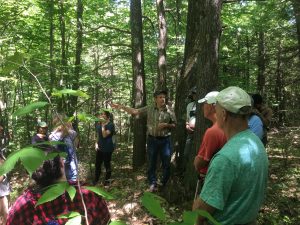
On a sunny Sunday in June, 25 community members joined HLT to hike the Stevens property trails and learn about forest management. We also looked at, but mostly listened to, birds. Lincoln Fish, the consulting forester for a timber harvest that is planned for this fall at Stevens, led the hike, while talking about the harvest set to be completed this year. The harvest is part of the Foresters for the Birds program, a partnership between the Massachusetts Department of Conservation and Recreation, Mass Audubon, and the Massachusetts Woodlands Institute.
We stopped by a portion of Stevens that was cut 10 years ago, creating habitat for moose, porcupine, and many species of birds. This small shrub sapling area created by the harvest is also known as “early successional habitat.” The group noted a black and white warbler, an oven bird, a hummingbird, as well as 10 other species. Lincoln explained that this area is attractive to moose and bird species, who thrive in the small shrub sapling habitat, but once the trees grow larger, the moose will move on and the area will resemble the surrounding forest.

Our group continued to the false summit of Mount Pisgah and the nearby site of the future timber harvest. Lincoln explained the goals for this harvest are to create more shrub land habitat for bird species and a vista view for hikers. The priority of the harvest is to create habitat, meaning the resale value won’t determine which trees are cut: some marketable trees will be left as habitat resources while other harvested trees may be unmarketable.
Many species rely on multi-aged forest structures–forests that have sections of habitat that are in different stages of growth. As Lincoln told us, “you can’t be all things for all species on only one acre of forest.” The timber harvest on the Stevens property means we will create habitat for more species to enjoy on a small piece of this large, conserved forest land!
